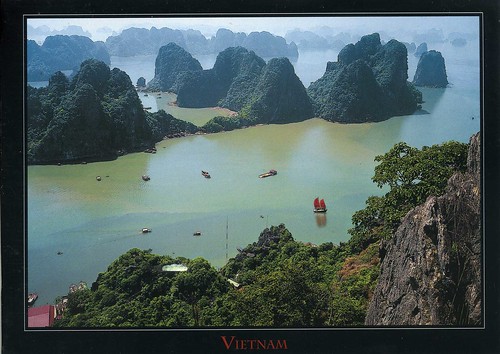
This postcard shows Ha Long Bay, a UNESCO World Heritage Site, and a popular travel destination, located in Quảng Ninh province, Vietnam. The bay features thousands of limestone karsts and isles in various sizes and shapes. Ha Long Bay is a center of a larger zone which includes Bái Tử Long bay to the northeast, and Cát Bà islands to the southwest. These larger zones share similar geological, geographical, geomorphological, climate, and cultural characters.
Ha Long Bay has an area of around 1,553km2, including 1,960 islets, most of which are limestone. The core of the bay has an area of 334km2 with a high density of 775 islets. The limestone in this bay has gone through 500 million years of formation in different conditions and environments. The evolution of the karst in this bay has taken 20 million years under the impact of the tropical wet climate. The geo-diversity of the environment in the area has created biodiversity, including a tropical evergreen biosystem, oceanic and sea shore biosystem. Ha Long Bay is home to 14 endemic floral species and 60 endemic faunal species.
Historical research surveys have shown the presence of prehistorical human beings in this area tens of thousands years ago. The successive ancient cultures are the Soi Nhụ culture around 18,000-7,000 BC, the Cái Bèo culture 7,000-5,000 BC and the Hạ Long culture 3,500-5,000 years ago. Ha Long Bay also marked important events in the history of Vietnam with many artifacts found in Bài Thơ Mout, Đầu Gỗ Cave, Bãi Cháy.

The stamp is from a set of 4 stamps issued in 2009, showing Ornamental Fish. This one here is Centropyge flavissima, I have no idea of the possible English name.



 Maroon
Maroon 










































































































































































No comments:
Post a Comment